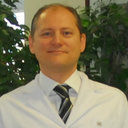Treatment differences in cases with venous angioma.
Nøgleord
Abstrakt
Venous angiomas were found to be the most common cerebral vascular malformations, composing 63% of such lesions in two autopsy series. Annual bleeding risk associated with venous angiomas is about 0.22 % per year. Venous angiomas are generally silent lesions because of their dynamic features, and are low flow and low pressure vascular structures draining normal brain tissue. An angioma rarely causes symptoms such as bleeding, seizure, hemifacial spasm, trigeminal neuralgia, aqueduct compression, nonhemorrhagic infarction and thrombosis of the draining vein. Even if it should bleed, the lesion can be managed conservatively in asymptomatic or mildly symptomatic patients. In this paper we report two venous angioma cases. The first patient bled twice in a short period of time and the angioma was located at the posterior fossa next to the left lateral recess. The second patient recently suffered a cerebral stroke that was located in the vicinity of the right caudate nucleus and not associated with the venous angioma that was located next to the left caudate nucleus. This patient had been under warfarin sodium treatment for 14 years due to his previous coronary artery bypass surgery, but unknowingly there was a venous angioma located next to the caudate nucleus.


